The Complete Online Filmmaking Reference - Film Distribution ...
The Complete Online Filmmaking Reference - Film Distribution ...
The Complete Online Filmmaking Reference - Film Distribution ...
Create successful ePaper yourself
Turn your PDF publications into a flip-book with our unique Google optimized e-Paper software.
<strong>Film</strong> cameras<br />
How <strong><strong>Film</strong>making</strong> Cameras Work<br />
Movies don't move. A movie is a series of still pictures presented to the viewer so rapidly that the viewer's brain<br />
is fooled into thinking the images are moving. <strong>The</strong> eye holds the image of one picture for a moment after it is no<br />
longer shown until the next picture appears. This is called persistence of vision and allows movies to work.<br />
Movies consist of 24 separate still photographs projected each second. This is just fast enough to generally<br />
convince the eye that the images are alive and moving.<br />
Cameras use a lens to focus the light rays coming from the scene onto a small rectangular area of film or, in the<br />
case of video, onto an electronic circuit that is sensitive to light. In a film camera a shutter opens allowing light to<br />
shine on the film for a moment, then the shutter closes and the film is advanced to the next frame by a claw<br />
mechanism. <strong>The</strong>n the process repeats 1/24th of a second later. In a video camera light is gather by the electronic<br />
circuit for a fraction of a second then the brightness and color values are read out of the circuit for processing<br />
and writing to some form of memory.<br />
<strong>Film</strong> formats<br />
<strong>Film</strong> consists of light sensitive chemicals coated on a thin, clear cellulose acetate or other flexible plastic film. <strong>The</strong><br />
chemicals are color dyes and silver compounds (explaining the high cost of photographic film). Most high-budget,<br />
professional films are still shot on 35mm color film stock. 35mm film has been the common format since the very<br />
first movies.<br />
When the film is processed it becomes a negative image of the original scene with the lightest areas of the<br />
original scene represented as black on the film, and the darkest areas of the scene staying light and transparent<br />
on the film. Colors are also reversed. A positive print has to be made from the negative in order to view the film<br />
correctly.<br />
16mm is a lower cost alternative but somewhat lower quality. A few filmmakers experiment with super-8mm but<br />
the results don't hold up well in theater projection. All the world's theater projectors are 35mm so any other film<br />
size will have to be enlarged and reprinted onto 35mm at some point if it is to be shown in theaters.<br />
<strong>Film</strong> can be shot in a variety of rectangular shapes called aspect ratios. A movie's aspect ratio is given as a ratio<br />
of the width of the frame divided by the height. <strong>The</strong> classic size of 35mm film and standard definition television is<br />
a width of 4 units and a height of 3 units giving an aspect ratio of 1.33:1. This aspect ratio is often referred to as<br />
Academy aperture after the Academy of Motion Picture Arts and Sciences which first defined and standardized it.<br />
Although the Academy frame was standard for most of the early years of filmmaking a wider aspect ratio is now<br />
preferred. In America the most common ratio is a 1.85:1 widescreen ratio. Most European films are shot with a<br />
1.66:1 ratio making them not quite as wide as American films project for the same height. <strong>The</strong> film is shot on the<br />
same 35mm film stock but the top and bottom of each frame is cropped by masking it off in the cameras and<br />
projectors. High definition video uses an aspect ratio of 16 to 9 units, or 1.78:1 which is very close to 1.85:1<br />
widescreenand makes a transfer to film possible with only a small amount of cropping.<br />
Another popular format is anamorphic widescreen having an aspect ratio of 2.35:1. It is sometimes referred to as<br />
scope after the trade name Cinemascope. Scope is also shot on the same 35mm stock and the extra wide aspect<br />
ratio is achieved by a combination of cropping the top and bottom of the frame and using a special anamorphic<br />
lenses which images the scene onto the film by squeezing the image more horizontally than vertically.<br />
35mm cameras are generally very large, heavy and cumbersome pieces of equipment. <strong>The</strong>y require substantial<br />
tripods and dollies and several operators to use them. Some newer cameras are small and light enough to be<br />
handheld or supported on a Steadicam, a support that is attached to an operator and keeps the camera steady<br />
while the operator walks through the scene.<br />
35mm production is worth it when the budget is large enough as non of the current video formats can quite equal<br />
the quality.<br />
A few productions are even shot using special 65mm or 70mm film and cameras. <strong>Film</strong>s such as Lawrence of<br />
Arabia and the popular IMAX films have startlingly rich and detailed images.<br />
<strong>Film</strong> sound


